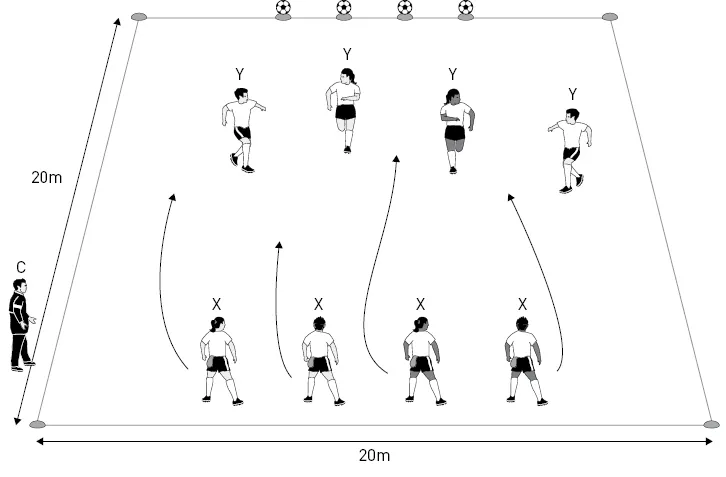![]()
Warming up is one of the most important aspects of your coaching session. It is vital that your players are warmed up properly in order to maximise their performance and reduce the risk of injury. A warm-up also helps the players to concentrate on the session ahead.
All of our warm-up sessions can be used at the beginning of any coaching session as they are inclusive and are not restricted to one specific football technique. Particular emphasis is given to the importance of developing and mastering the basic physical literacy skills of agility, balance, co-ordination and speed, along with spatial awareness.
session 1 cone commands
Organisation: Set out a 20 x 20m area
Equipment: Bibs, marker cones, footballs.
Description: Players move around inside the area. Without speaking, the coach holds up one cone at a time with each colour having a simple movement instruction to follow.
Examples of instructions: Green cone = go (move around the area); red cone = stop (stand still); yellow cone = get ready to go (jog on the spot); blue cone = move around the area backwards; white cone = players lay down on their back on the floor (if it’s not wet or muddy).
Key coaching points: Encourage lots of movement. Spatial awareness. Observational skills.
Progression: Coach makes up more colour commands. Add a ball per player, so players can dribble around the area while watching out for each command to then perform.
session 2 cops & robbers
Organisation: Set out a 20 x 20m area with four traffic cones placed in the middle of each side. Select one player to be the catcher (X). All other players (Y) take a bib each and place it into the waistband of their shorts, hanging down like a tail.
Equipment: Traffic cones, bibs.
Description: The cop (X) tries to catch the robbers (Y) by chasing them around the area trying to pull out their bibs. Once the bib is pulled out, the robber has been caught and has to ‘go to jail’ and is out of the game. If a robber has their hand on any of the four traffic cones, they are in the ‘safe house’ and cannot be caught, but they may only stay in the safe house for a maximum of five seconds.
Key coaching points: Look around to make sure you don’t get caught, and see the ‘safe houses’. When a cop chases you, turn to face them so that it’s harder for them to pull out the bib. Move in as many different directions as you can.
Progression: Add extra cops. Reduce the amount of ‘safe houses’. When a robber gets caught they become a cop.
session 3 noughts & crosses
Organisation: Set out nine hoops, mats, quoits or cones in a 3 x 3 grid. Organise the players into teams of three, holding a bib each and stationed 15m away from the grid. Each team needs to have a different coloured bib, i.e. red v blue.
Equipment: Marker cones, bibs.
Description: This is played as a 3 v 3 game of noughts and crosses. One player from each team runs out and places their bib on top of a cone then returns to their team. The next player then runs out and places their bib on top of a cone, attempting to make a line or block the opposition from making a line. If all three bibs from each team are placed into the grid but there is no winner, the players keep rotating until one team successfully makes a line of three bibs in a row.
Key coaching points: Move quickly to gain an advantage over the other team. Decision making – think about trying to make a line of three or blocking your opponents from making a line of three.
Progression: Advance the game into a 4 x 4 grid with a line of four required to win the game.
session 4 knock knock
Organisation: Set out a 20 x 20m area and balance four footballs on top of small cones at one end. Select four defenders (Y) who start in the middle of the area, and four attackers (X) who start on the opposite baseline and each have a bib placed it into the waistband of their shorts, hanging down like a tail.
Equipment: Marker cones, bibs, footballs.
Description: The X players attempt to evade the defenders (Y), make it to the other end of the area and knock off one of the four footballs. If the defender is able to catch the attacker by pulling out their tail, they swap roles and start again. If the attacker manages to knock a ball off, they are awarded one point, then reset the ball and have another go.
Key coaching points: Move quickly to lose your defender. Spatial awareness.
Progressions: Play 1 v 1 as a relay in teams. Move the four footballs to the other sides of the square to change the angle of attack and defence.
session 5 action ball
Organisation: Set out a 20 x 20m area with a large number of different coloured small cones scattered at one end. Set up players into two teams (X and Y), with players competing 1 v 1 inside the area.
Equipment: Marker cones, bibs, football.
Description: With one player from each team starting in the centre on the baseline, the coach calls out a colour and then throws the ball into the area. The players then race to...






